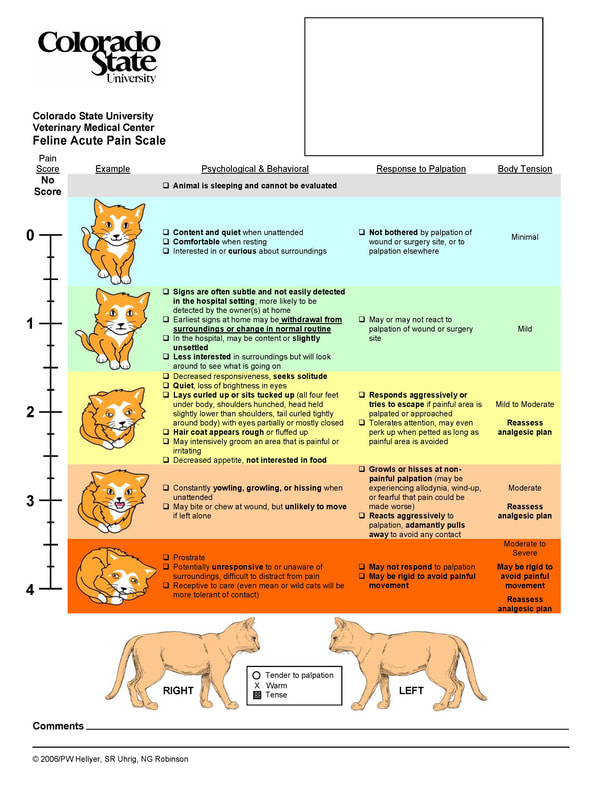|
Over the last several years, the concepts of pain and pain management have become more widespread within the veterinary community. There has been a growing need to understand the physiology of pain, identify the signs of pain, and be able to provide pain relief to our patient population, in order to enhance our patients’ comfort and overall quality of life. The International Association for the Study of Pain defines pain as, “an unpleasant sensory and emotional experience associated with actual or potential tissue damage”. Pain starts through stimulation of pain receptors (called nociceptors) that are present within the central nervous system, and are responsible for causing a pain response. Pain is a sensory process (nociception) that involves a series of electrical events, starting at the site of tissue injury, which then conveys signals to the brain, and results in the perception of pain (Figure 1). Perception is how the animal feels pain and is a subjective experience. Signs of pain can be classified as either behavioral or physiological. Behavioral signs are usually recognized first as they occur outwardly and are more readily observed. Physiological signs are systemic in nature, and therefore require a more hands on approach for assessment. Both behavioral and physiological signs are summarized below (Table 1). Sometimes, an animal’s behavior changes depending on changes in their environment. For instance, an animal in a hospital setting may exhibit different behaviors compared to their more comfortable and familiar home environment. It’s important to give a thorough history to your veterinary provider about what’s normal and abnormal in their pet’s behavior. Behavior can also be modified in times of fear, anxiety and stress, which a hospital setting can also contribute to. When your veterinary provider performs an overall assessment on your pet, they’re looking for physiological changes that could be the result of pain. Part of their assessment should involve evaluation using a pain scoring system or pain scale, which is a tool to help assess an animal’s pain level. Pain scales are a means of documenting an objective measurement and assessment of pain. In the author’s experience, the use of Colorado State University’s canine and feline acute pain scales has shown to be most objective in veterinary pain assessments. The scoring system is somewhat of a combination of visual and numerical evaluation systems and has been adapted from the human field for animals (Figure 2 & 3). Using pain scales helps to not only have a baseline of an animal’s pain level at the time of presentation, but are also useful to monitor the animal’s response to pain management. When it comes to pain management, the term analgesia is used, which by definition means absence of pain, or loss of sensitivity to pain. An analgesic is a drug or agent that allows pain relief. The analgesia options available in veterinary medicine are ever evolving, as more awareness and research is done to understand pain. The most common types of drugs used to help alleviate pain include opioids, which are centrally acting pain relievers, and non-steroidal anti-inflammatories (NSAIDs), which relieve inflammation more locally at the site of tissue injury. It’s important to note that human NSAID medications available over the counter (i.e. ibuprofen, naproxen, aspirin, acetominophen) are not safe for animals, as they can cause kidney and liver damage. There are also additional therapies such as local anesthetics (to help with surgical pain) and laser therapy treatments. Your veterinarian and veterinary technician team want to provide the best care for your pet by advocating what’s in their best interests! It’s important to consult with them about what best pain medication or therapy is indicated based on your pet’s disease process and needs. Guest AuthorCourtney Waxman, CVT, RVT, VTS (ECC) is an Arizona native who found her passion in emergency and critical care medicine after completing an internship during her technician schooling. She attended Mesa Community College and obtained her Certified Veterinary Technician (CVT) credential for Arizona in 2008 and her Registered Veterinary Technician (RVT) credential for Indiana in 2018. In 2017, Courtney earned her Veterinary Technician Specialty (VTS) certification in Emergency and Critical Care (ECC). She currently works as an instructor for Purdue University’s Veterinary Nursing Program and as a per diem technician in Purdue’s Veterinary Teaching Hospital emergency and ICU services.
Comments
|

Ready to Work Together?
Thank you!You have successfully joined our subscriber list. This website is NOT a substitute for veterinary care with a veterinarian. We recommend you follow the advice and treatment plan as prescribed by your veterinarian, and only after discussing anything found on this website with your veterinarian, with their approval, implementing advice found here.
Most of the information on this site is free for you to read, watch or listen to, but Internal Medicine for Pet Parents is also a business. So please expect hyperlinks to be affiliate links in many cases, where we receive a small percentage of sales if you wish to purchase. We only recommend tools, books and services that we use, or people we know personally. Integrity and authenticity continue to be of the highest importance to us. Read the privacy policy here. We hope you find the site useful! Thanks – Yvonne and Ashley Check us out on Facebook!
Categories
All
Archives
October 2019
|







 RSS Feed
RSS Feed